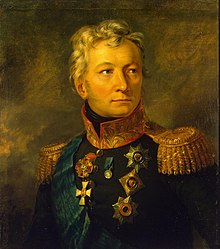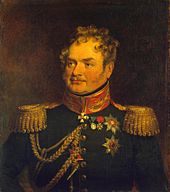Battle of Kobrin
| date | July 27, 1812 |
|---|---|
| place | Kobrin , today Belarus |
| output | Russian victory |
| Parties to the conflict | |
|---|---|
| Commander | |
| Troop strength | |
| 5,000 men | 16,000 to 18,000 men |
| losses | |
|
2000 dead and 2300 prisoners |
77 dead and 181 wounded |
Mir - Mogilev - Ostrovno - Kobrin - Klyastitsy - Gorodeczno - Smolensk - Polotsk I - Walutino - Borodino - Tschirikovo - Tarutino - Maloyaroslavets - Polotsk II - Vyazma - Lyachovo - Chaschniki - Smoljany - Krasnoi - Beresina
The battle of Kobrin took place on July 15th . / July 27, 1812 greg. during Napoleon's Russian campaign on the southern wing in the area east of Brest . A Saxon troop contingent in Kobrin was surrounded by Russian troops and taken prisoner.
prehistory
In the first weeks of the campaign, Napoleon underestimated the strength of the Russian 3rd Army under Tormassow . Between July and September 1812 the situation on the southern flank became dangerous for Napoleon's grand army. Admiral Tschitschagow's Danube Army was about to unite with the 3rd Army near Lutsk in northwestern Ukraine. General Tormasov also had to protect the northern border of the Ukraine and therefore had to thin out the ranks of his 45,000 men. Nevertheless, his troops were far superior in size to the French-Saxon VII Corps with about 19,000 men under General Reynier. This corps was tasked with covering Napoleon's original southern flank. Urged by Tsar Alexander and General Bagration , Tormasov advanced north towards the territory of the Duchy of Warsaw . As early as mid-July, Tormassov's light troops broke into the Duchy near Wlodawa , Rubieszow and Krilowo across the Bug River . These forays spread fear and terror as far as Warsaw . Many Poles believed that the Russians could occupy Warsaw themselves in a bold advance. However, Tormassov's plan was to take the French army in the back and cause far more lasting damage than a temporary capture of Warsaw.
The ratification of the peace with the Ottoman Sultan was able to calm the tense nerves of the Russian military leadership and the Tsar. The danger persisted until the end that the Turkish troops could attack the thinned lines of the Russians in Ukraine. After the raids over the Bug had created the necessary uncertainty among the enemy, General Tormasov was able to withdraw his troops around July 22nd, and turned with his entire army northward to unite with the divisions under Kamenski's command. On July 24th, General Cherbatov's division occupied Brest .
Troops involved
French-Saxon VII Army Corps under General Jean-Louis-Ebenezer Reynier - approx. 19,000 men
Commander Vanguard: Major General Heinrich von Klengel
- 2 battalions of line infantry of the 1st König regiment (Saxony)
- 6 companies of the line infantry of the 2nd Niesemeuschel Regiment (Saxony)
- 3 squadrons of Uhlans (Saxony)
Russian 3rd Army under General Alexander Petrovich Tormassow - approx. 45,000 men
- 13th Infantry Division under General Count Charles de Lambert - approx. 15,000 men, including cavalry units (approx. 1–2 fighter regiments)
The battle
On July 27, 1812, the Russian armed forces approached the small town of Kobrin. General Tormasov came from the south, and the divisions of Count Lambert and General Tscherbatow came from the west. General Reynier stood at Pruszany with the bulk of his VII Corps . The Saxon vanguard under the command of General Klengel kept Kobrin occupied. Smaller outposts had taken up positions in Brest, Janow and Pinsk. General Tormassow ordered General Tschaplitz's avant-garde division to bypass Kobrin from the east and leave little cavalry behind to block Klengel's troops, which were holed up in the buildings on the southern outskirts. After the Russians had driven the Saxon outposts from the three places, the Russian infantry and cavalry attacked the Saxon brigade from Dywin and Harodezka at 6 a.m. on July 27 and threw the defenders back into the city of Kobrin after heavy resistance. Just two hours later, the crew was completely enclosed. The Saxons limited themselves to defending the gates of Kobrin and the bridges over the Mukhavets river. An attempt by the Saxon Uhlans to break through the enclosure failed. Kobrin was set on fire by the Russian guns. In addition, the Saxon defenders ran out of powder and bullets. Already at 2 p.m. they had to surrender to the Russians, who attacked five times as much.
Of the 2,300 men in the garrison, around 1,000 died or were wounded. General Klengel, 3 colonels and 63 other officers were taken prisoner. Four flags, 8 cannons and all personal equipment of the Saxons fell into the hands of the Russians.
Effects
General Tormasov was criticized after the Kobrin meeting for failing to use his chance to wipe out Reynier's corps completely. This accusation was not justified, because in the lost battle of Gorodeczno / Podobna on July 31 . / August 12, 1812 greg. the initiative passed back to the Grande Army . This gave Napoleon time to order the Austrian troops under Prince Schwarzenberg to reinforce Reynier's corps south. In view of this superiority, General Tormasov was forced to go back to a strong defensive position on the Styr River . The victory at Kobrin not only boosted the morale of the Russians, but also pulled the 30,000 Austrian soldiers further south from the main theater of war.
literature
- Clemens-Franz-Xaver von Cerini: Campaigns of the Saxons in the years 1812 and 1813. Dresden 1821, p. 17ff.
- Franz Röder: Napoleon's campaign against Russia in 1812 , Wilhelm Engelmann Verlag, Leipzig 1848, p. 48
- M. Bogdanowitsch: History of the campaign of 1812 , first volume, Verlag Bernhard Schlicke Leipzig 1863, p. 300 f.
- Dominique Lieven: Russia against Napoleon 1812 , Verlag C. Bertelsmann 2011
- Adam Zamoyski: Napoleon's war against Russia in 1812 , CH Beck, Munich 2012
Web links
- Wikisource description of the Battle of Kobrin (Военная энциклопедия (Сытин, 1911-1915), Russian)



